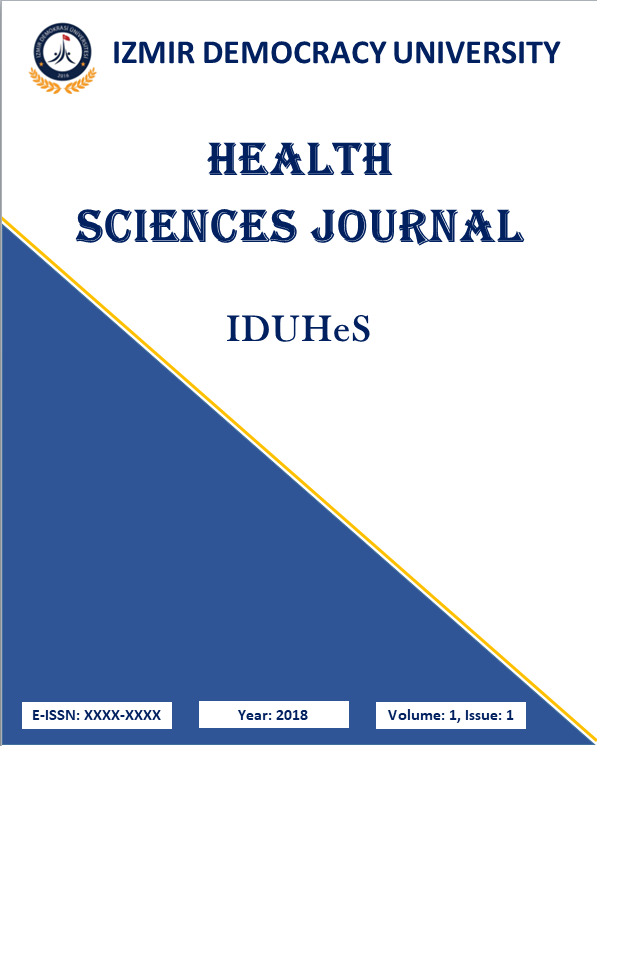Tip 1 Diabetes Mellituslu 12- 18 Yaş Arası Adölesanlarda Kan Şekeri Ölçüm Becerilerini Değerlendirme Ölçeği: Ölçek Geliştirme Çalışması
Tip 1 Diyabet, Geçerlik ve güvenirlik, Kan Glukoz Ölçümü, Ölçek geliştirme, Adölesan.
BLOOD GLUCOSE MEASURING SKILLS of ADOLESCENTS AGED BETWEEN 12 and 18 YEARS with TYPE 1 DIABETES MELLITUS: INSTRUMENT DEVELOPMENT and PSYCHOMETRIC TESTING
Blood Glucose Measurement, Skill, Type 1 Diabetes, Adolescent, Scale Development,
___
- 1. Doherty, A. (2015). Psychiatric aspects of diabetes mellitus. BJPsych Advances, 21(6), 407-416. doi:10.1192/apt.bp.114.013532
- 2. American Diabetes Association. (2021) Introduction: Standards Of Medical Care In Diabetes-2021. Diabetes Care. ( Supplement_1):S1–S2. doi: 10.2337/dc21-Sint.
- 3. Felner, E. I., Klitz, W., Ham, M., Lazaro, A. M., Stastny, P., Dupont, B., & White, P. C. (2005). Genetic interaction among three genomic regions creates distinct contributions to early- and late-onset type 1 diabetes mellitus. Pediatric diabetes, 6(4), 213–220. https://doi.org/10.1111/j.1399-543X.2005.00132.x
- 4. International Diabetes Federation (IDF). (2021). Diabetes Atlas. 10th Edition,Access Address: https://diabetesatlas.org/atlas/tenth-edition/ Access Date: July 16, 2022
- 5. Ogle, G. D., James, S., Dabelea, D., Pihoker, C., Svennson, J., Maniam, J., Klatman, E. L., & Patterson, C. C. (2022). Global estimates of incidence of type 1 diabetes in children and adolescents: Results from the International Diabetes Federation Atlas, 10th edition. Diabetes research and clinical practice, 183, 109083. https://doi.org/10.1016/j.diabres.2021.109083
- 6. Phillips, J. E., Couper, J. J., Penno, M., Harrison, L. C., & ENDIA Study Group (2017). Type 1 diabetes: a disease of developmental origins. Pediatric diabetes, 18(6), 417–421. https://doi.org/10.1111/pedi.12425.
- 7. Ortiz, M., & Ortiz, E. (2005). Adherencia al tratamiento en adolescentes diabéticos tipo 1 chilenos: una aproximación psicológica [Psychological factors associated to patient's treatment compliance in Chilean diabetic teenagers]. Revista medica de Chile, 133(3), 307–313. https://doi.org/10.4067/s0034-98872005000300006.
- 8. Lowes, L., Eddy, D., Channon, S., McNamara, R., Robling, M., Gregory, J. W., & DEPICTED study team (2015). The experience of living with type 1 diabetes and attending clinic from the perception of children, adolescents and carers: analysis of qualitative data from the DEPICTED study. Journal of pediatric nursing, 30(1), 54–62. https://doi.org/10.1016/j.pedn.2014.09.006.
- 9. Boogerd, E. A., Noordam, C., Kremer, J. A., Prins, J. B., & Verhaak, C. M. (2014). Teaming up: feasibility of an online treatment environment for adolescents with type 1 diabetes. Pediatric diabetes, 15(5), 394–402. https://doi.org/10.1111/pedi.12103
- 10. Stahl-Pehe, A., Landwehr, S., Lange, K. S., Bächle, C., Castillo, K., Yossa, R., Lüdtke, J., Holl, R. W., & Rosenbauer, J. (2017). Impact of quality of life (QoL) on glycemic control (HbA1c) among adolescents and emerging adults with long-duration type 1 diabetes: A prospective cohort-study. Pediatric diabetes, 18(8), 808–816. https://doi.org/10.1111/pedi.12487
- 11. Forsander, G., Bøgelund, M., Haas, J., & Samuelsson, U. (2017). Adolescent life with diabetes-Gender matters for level of distress. Experiences from the national TODS study. Pediatric diabetes, 18(7), 651–659. https://doi.org/10.1111/pedi.12478
- 12. Agarwal, S., Garvey, K. C., Raymond, J. K., & Schutta, M. H. (2017). Perspectives on care for young adults with type 1 diabetes transitioning from pediatric to adult health systems: A national survey of pediatric endocrinologists. Pediatric diabetes, 18(7), 524–531. https://doi.org/10.1111/pedi.12436
- 13. Shrivastava, S.R., Shrivastava, P.S. & Ramasamy, J. Role of self-care in management of diabetes mellitus. J Diabetes Metab Disord 12, 14 (2013). https://doi.org/10.1186/2251-6581-12-14
- 14. DiMeglio, L. A., Acerini, C. L., Codner, E., Craig, M. E., Hofer, S. E., Pillay, K., & Maahs, D. M. (2018). ISPAD Clinical Practice Consensus Guidelines 2018: Glycemic control targets and glucose monitoring for children, adolescents, and young adults with diabetes. Pediatric diabetes, 19 Suppl 27, 105–114. https://doi.org/10.1111/pedi.12737
- 15. Abubakari, A. R., Cousins, R., Thomas, C., Sharma, D., & Naderali, E. K. (2016). Sociodemographic and Clinical Predictors of Self-Management among People with Poorly Controlled Type 1 and Type 2 Diabetes: The Role of Illness Perceptions and Self-Efficacy. Journal of diabetes research, 2016, 6708164. https://doi.org/10.1155/2016/6708164
- 16. Ercan, I. and Kan, I. (2004) Reliability and Validity in Scales. Uludag Universiy Journal of College of Medicine, 30, 211-216 17. Westen, D., & Rosenthal, R. (2003). Quantifying construct validity: two simple measures. Journal of personality and social psychology, 84(3), 608–618. https://doi.org/10.1037//0022-3514.84.3.608
- 18. Davis, L. L. (1992). Instrument review: Getting the most from a panel of experts. Applied Nursing Research, 5(4), 194–197. doi:10.1016/s0897-1897(05)80008-4
- 19. Tavşancıl, E. (2018). Measuring the attitudes and data analysis via SPSS. Ankara: Nobel Academy Pub.
- 20. Şimşek ÖF., Introduction to Structural Equation Models: Basic Principles and LISTREL Applications. İstanbul, Ekinoks Pub; 2007.
- 21. Büyüköztürk, Ş., Kılıç Çakmak, E., Akgün, Ö.E., Karadeniz, Ş. ve Demirel, F. (2012). Scientific Research Methods. Ankara: Pegem Academy; 2012.
- 22. Phelan, H., Lange, K., Cengiz, E., Gallego, P., Majaliwa, E., Pelicand, J., Smart, C., & Hofer, S. E. (2018). ISPAD Clinical Practice Consensus Guidelines 2018: Diabetes education in children and adolescents. Pediatric diabetes, 19 Suppl 27, 75–83. https://doi.org/10.1111/pedi.12762
- 23. Esin, MN. (2015). Data Collection Methods and Tools & Reliability and Validity of Data Collection Tools..In: Erdoğan S, Nahcivan N, Esin MN, editors. Research process, practice and critical in nursing. 2nd Edition. Istanbul: Nobel Medical Bookstores; 2015. 193–234.
- 24. Acemoğlu, H. & Aktürk, Z. (2012). Reliability and validity in medical research . Dicle Tıp Dergisi , 39 (2) , 316-319 . doi: 10.5798/diclemedj.0921.2012.02.0150
- Yayın Aralığı: Yılda 3 Sayı
- Başlangıç: 2018
- Yayıncı: İzmir Demokrasi Üniversitesi
İhsan KISADERE, Hakan TAVŞANLI, Mehmet Faruk AYDIN
Frontal Lob Sendromu Belirtileri ile Başvuran İntrakranial Tümör
KALP YETERSİZLİĞİNDE SAĞLIK İNANÇ MODELİ’NE DAYALI YAPILAN ARAŞTIRMALAR: SİSTEMATİK BİR İNCELEME
Dilan DENİZ AKAN, Ozden DEDELİ CAYDAM
İNSANLARDAKİ COVID-19 YABAN HAYVANLARINDA RİSK OLUŞTURUYOR MU?
Basak HANEDAN, Ali BİLGİLİ, Nigar ABBASOVA
SAĞLIKLI BİREYLERDE CİNSİYETLER ARASINDA ÜST EKSTREMİTE FONKSİYONELLİĞİ AÇISINDAN FARK VAR MIDIR?
Yusuf EMÜK, Turhan KAHRAMAN, Yeşim ŞENGÜL
ÜNİVERSİTE ÖĞRENCİLERİNDE AKDENİZ DİYETİNE UYUM DÜZEYİ İLE UYKU KALİTESİ ARASINDAKİ İLİŞKİ
Azra BALKANLI, Kezban Esen KARACA, Merve SAVICI
HEMŞİRELİK ÖĞRENCİLERİNİN COVID-19 PANDEMİ DÖNEMİNDE ZAMAN YÖNETİMİ BECERİLERİNİN İNCELENMESİ
Gülbin KONAKÇI, Ceyda GÜMÜŞ, Umut ÖZDEMİR
Oosit Kriyoprezervasyonu: Türk Ebelik ve Hemşirelik Öğrencilerinin Bilgi ve Tutumu
İlkay GÜNGÖR SATILMIŞ, Gözde KÜĞCÜMEN, Özden TANDOĞAN
Meltem AKBAŞ, Emine İBİCİ AKÇA, Cemile ONAT KÖROĞLU, Şule GÖKYILDIZ SÜRÜCÜ
